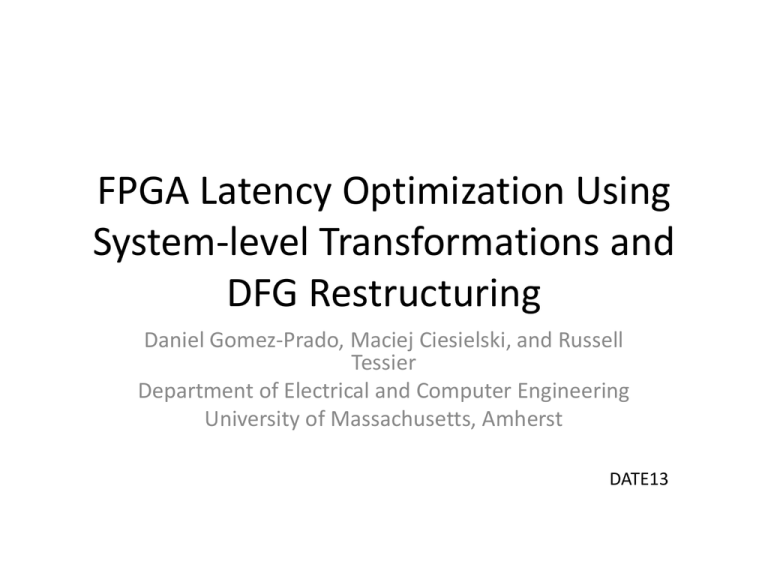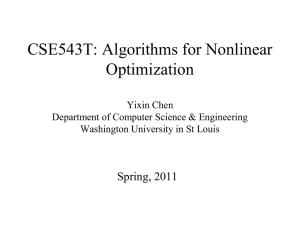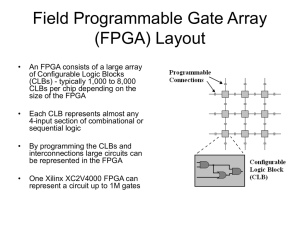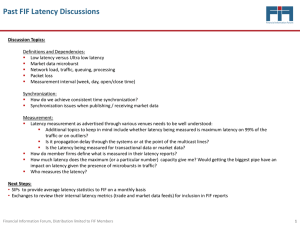FPGA Latency Optimization Using System
advertisement

FPGA Latency Optimization Using System-level Transformations and DFG Restructuring Daniel Gomez-Prado, Maciej Ciesielski, and Russell Tessier Department of Electrical and Computer Engineering University of Massachusetts, Amherst DATE13 Outline • INTRODUCTION • FPGA DESIGN LATENCY OPTIMIZATION DURING HIGH LEVEL SYNTHESIS • REVIEW OF TAYLOR EXPANSION DIAGRAMS • SYSTEM LEVEL EXPLORATION • EXPERIMENTAL RESULTS • CONCLUSIONS INTRODUCTION • Much FPGA design exploration work has focused on optimizations which are performed during traditional highlevel synthesis (HLS), such as operation scheduling, register binding, and functional unit allocation. • In this paper we show that it is possible to rapidly explore and modify dataflow graph representations at the behavioral level to improve FPGA design latency. INTRODUCTION • New design flow consists of the following phases: – 1) High-level algorithmic transformation using TEDs. – 2) High-level synthesis using GAUT [3]. – 3) RTL design synthesis and physical design (place and route) using Altera Quartus II for commercial Stratix II FPGA devices. • We demonstrate that TED transformations can directly lead to an average of 22.6% post-mapped improvement in design latency. FPGA DESIGN LATENCY OPTIMIZATION DURING HIGH LEVEL SYNTHESIS • In Chen and Cong [1],a register binding algorithm with multiplexer optimization is modeled as a minimum cost flow in a network, and then a greedy algorithm is used to optimize performance. • The problem of register binding for clock period minimization without register overhead is formulated in Huang and Chen [4]. FPGA DESIGN LATENCY OPTIMIZATION DURING HIGH LEVEL SYNTHESIS • Cong et al. [5], the overall resource usage of functional units , registers and multiplexers is simultaneously optimized. The scheduler transmits global optimization information between each step of the algorithm. • In Kim and Liu [6], a simultaneous register and functional unit binding algorithm targeting multiplexer input reduction to shorten the total interconnect length is developed. FPGA DESIGN LATENCY OPTIMIZATION DURING HIGH LEVEL SYNTHESIS • The low-power architectural synthesis system (LOPASS) [7] performs a simulated-annealing optimization over the entire synthesis process to effectively reduce power. • Our method is complementary to the previous approaches as it restructures a dataflow graph prior to high level synthesis in an attempt to create a DFG which minimizes design latency. REVIEW OF TAYLOR EXPANSION DIAGRAMS • A TED is a canonical, graph-based data structure that can efficiently represent designs expressed as multivariate polynomial expressions. REVIEW OF TAYLOR EXPANSION DIAGRAMS • DFG Generation: – The DFG representation is not unique. While the number of operations remains fixed, a DFG can be further restructured and/or balanced to minimize latency. • DFG Selection and Optimization: – DFG does not minimize the number of hardware resources. Such an optimization is only possible by performing scheduling and resource allocation for the selected DFG. REVIEW OF TAYLOR EXPANSION DIAGRAMS • TED-based Decomposition System (TDS): – TDS [8], which transforms the function extracted from a design specification into a TED and uses a host of TEDbased decomposition and DFG optimization techniques to obtain an optimized DFG. REVIEW OF TAYLOR EXPANSION DIAGRAMS SYSTEM LEVEL EXPLORATION • Estimating resource usage within the TED: SYSTEM LEVEL EXPLORATION • Computing the critical path delay from a TED: – The critical path delay algorithm traverses all nodes of the TED and computes the height . When an edge connecting a node to its children contains a register, the height contributed by that child is assigned 0 as if it were a primary input. SYSTEM LEVEL EXPLORATION • Iterative high level synthesis: – The annealing algorithm accepts and rejects the new costs which calibrates the window size into which a TED performs reordering and decomposition. SYSTEM LEVEL EXPLORATION SYSTEM LEVEL EXPLORATION SYSTEM LEVEL EXPLORATION SYSTEM LEVEL EXPLORATION Design latency (clock period × number of clock cycles) EXPERIMENTAL RESULTS • Best result is output by GAUT in VHDL and run through Altera Quartus synthesis, place and route to validate the improvements reported by GAUT. EXPERIMENTAL RESULTS EXPERIMENTAL RESULTS CONCLUSIONS • A new FPGA design latency optimization tool has been demonstrated. • For a collection of benchmark designs our approach shows a 22% reduction in design latency.








